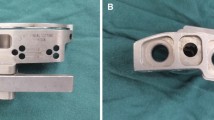Abstract
The purpose of our study was to calculate the optimal tibial resection depth in total knee arthroplasty. The data from 464 navigated total knee arthroplasties were analysed. An implant with a minimum insert thickness of 8 mm was used. Data regarding leg axis, joint line, insert thickness and tibial resection depth were recorded by the navigation device. An algorithm was developed to calculate the optimal tibial resection depth. The required tibial resection significantly correlates with the preoperative leg axis (p < 0.001). In valgus deformities the required resection depth averaged 5.1 mm and was significantly reduced compared to knees with a neutral leg axis (6.8 mm, p < 0.001) and varus deformities (8.0 mm, p < 0.001). Manufacturers recommend undercutting the high side of the tibial plateau to the depth of the thinnest insert available. However, our study demonstrates that in valgus deformities a reduced tibial resection depth is preferable. Hence, unnecessary bone loss can be avoided.



Similar content being viewed by others

References
Bae DK, Song SJ, Yoon KH (2010) Total knee arthroplasty following closed wedge high tibial osteotomy. Int Orthop 34:283–287
Bathis H, Shafizadeh S, Paffrath T, Simanski C, Grifka J, Luring C (2006) Are computer assisted total knee replacements more accurately placed? A meta-analysis of comparative studies. Orthopade 35:1056–1065
Berend ME, Small SR, Ritter MA, Buckley CA (2009) The effects of bone resection depth and malalignment on strain in the proximal tibia after total knee arthroplasty. J Arthroplasty 25:314–318
Brooks P (2009) Seven cuts to the perfect total knee. Orthopedics 32:27. doi:10.3928/01477447-20090728-27
Chiu KY, Yau WP, Ng TP, Tang WM (2008) The accuracy of extramedullary guides for tibial component placement in total knee arthroplasty. Int Orthop 32:467–471
Elkus M, Ranawat CS, Rasquinha VJ, Babhulkar S, Rossi R, Ranawat AS (2004) Total knee arthroplasty for severe valgus deformity. Five to fourteen-year follow-up. J Bone Jt Surg Am 86:2671–2676
Engh GA (2003) The difficult knee: severe varus and valgus. Clin Orthop Relat Res 416:58–63
Favorito PJ, Mihalko WM, Krackow KA (2002) Total knee arthroplasty in the valgus knee. J Am Acad Orthop Surg 10:16–24
Fehring TK, Christie MJ, Lavernia C, Mason JB, McAuley JP, MacDonald SJ, Springer BD (2008) Revision total knee arthroplasty: planning, management, and controversies. Instr Course Lect 57:341–363
Hartel MJ, Loosli Y, Gralla J, Kohl S, Hoppe S, Roder C, Eggli S (2009) The mean anatomical shape of the tibial plateau at the knee arthroplasty resection level: an investigation using MRI. Knee 16:452–457
Lee K, Goodman SB (2008) Current state and future of joint replacements in the hip and knee. Expert Rev Med Devices 5:383–393
Lustig S, Fleury C, Goy D, Neyret P, Donell ST (2010) The accuracy of acquisition of an imageless computer-assisted system and its implication for knee arthroplasty. Knee. doi:10.1016/j.knee.2009.12.010
Martin JW, Whiteside LA (1990) The influence of joint line position on knee stability after condylar knee arthroplasty. Clin Orthop Relat Res 259:146–156
Pape D, Kohn D (2007) Soft tissue balancing in valgus gonarthrosis. Orthopade 36:657–658
Patil S, D’Lima DD, Fait JM, Colwell CW Jr (2007) Improving tibial component coronal alignment during total knee arthroplasty with use of a tibial planing device. J Bone Joint Surg Am 89:381–387
Ranawat AS, Ranawat CS, Elkus M, Rasquinha VJ, Rossi R, Babhulkar S (2005) Total knee arthroplasty for severe valgus deformity. J Bone Joint Surg Am 87(Suppl 1):271–284
Schnurr C, Nessler J, Konig DP (2009) Is referencing the posterior condyles sufficient to achieve a rectangular flexion gap in total knee arthroplasty? Int Orthop 33:1561–1565
Whittaker JP, Dharmarajan R, Toms AD (2008) The management of bone loss in revision total knee replacement. J Bone Joint Surg Br 90:981–987
Yau WP, Leung A, Liu KG, Yan CH, Wong LL, Chiu KY (2007) Interobserver and intra-observer errors in obtaining visually selected anatomical landmarks during registration process in non-image-based navigation-assisted total knee arthroplasty. J Arthroplasty 22:1150–1161
Conflict of interest
The authors declare that they have no conflict of interest.
Author information
Authors and Affiliations
Corresponding author
Rights and permissions
About this article
Cite this article
Schnurr, C., Csécsei, G., Nessler, J. et al. How much tibial resection is required in total knee arthroplasty?. International Orthopaedics (SICOT) 35, 989–994 (2011). https://doi.org/10.1007/s00264-010-1025-5
Received:
Revised:
Accepted:
Published:
Issue Date:
DOI: https://doi.org/10.1007/s00264-010-1025-5



